With just over a week to explore the Mojave National Preserve, our spirits were high as we headed south out of the gloomy Pacific Northwest towards a forecast full of sun and warmer - during the day - temps.
We'd made a similar pilgrimage last year and had a great time, an unexpected snow storm making for a unique - if a bit chilly - experience. And so, after 20 hours of driving - and only a couple hours sleep at Pahranagat National Wildlife Refuge - we arrived at the north east corner of the Preserve: the Clark Mountains. This would be the starting point of out clockwise-ish jaunt - some of the places familiar, others never-before visited. But our first order of business was airing down.

As we passed through the Ivanpah Solar Power Plant - it was strangely idle on this sunny day.

The perfect spot to air down. For 8 days.
Our climb into the Clark Mountains was quick and easy - temps a little cooler than we'd expected, but nothing compared to the 10" of snow we'd encountered on our previous visit. Behind us, views into the Ivanpah Valley reminded us why it was that we enjoyed this spot in the world.

It was brunch time - for us anyway - when we reached the saddle where the enormous pit of the Colosseum Mine ate into the mountain. Unlike our previous visit, the gate was now closed - and locked - likely a result of all the extra traffic in the area during 2020, and the additional liability that the owners felt as a result. A bit bummed that we couldn't drive down to the water, @mrs.turbodb prepped a couple quick bowls of cereal, and we headed to the edge of the mine to peer down into the pit.
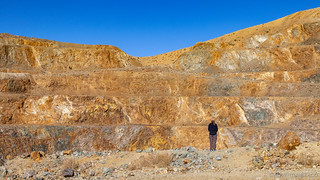
A relatively new mine as far as gold recovery in the Mojave Preserve is concerned, over $100 million was blasted out of this pit during the late 1980s and early 1990s. After mining ceased, the owners were required to mitigate some of the damage they had inflicted to the land. They graded and recontoured the waste-rock piles and stockpiles, revegetated certain areas, covered the tailings dam with waste rock to minimize erosion, and treated fresh rock surfaces to give them the appearance of desert varnish. This reclamation cost more than $30 million - a good fraction of the mine's gains. (Hiking the Mojave Desert)
Given that we'd visited the mine previously, we didn't spend all that long before heading off in a new direction - towards Clark Mountain - the unknown pulling us further from civilization.

A roundabout road wandered through the lower reaches of this, the highest summit in the preserve. Through pinyon pine forests, we eventually found ourselves at the old Curtis Cabin, its remote location affording it some protection from the crowds.
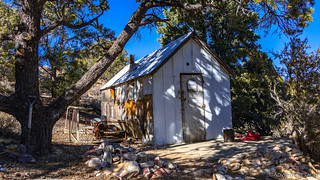
Inside, it was in sparse - but reasonable - condition, with a grill and propane stove amongst the amenities available to residents. I never really find myself wanting to stay in any of these cabins, but it's always comforting to find one that's lovingly cared for by someone, and respected by those who stumble upon it in their adventures.


Make sure to clock in and out, ya hear!
Frank Curtis, lived here for 27 years, nestled in amongst the folds of Clark Mountain. With little outside contact, there's no record of how much he mined from the nearby shaft - its headframe now collapsed after decades of harsh winters - but one thing is for certain, he had a great view every day he went to work.

From the cabin, we continued down the rough wash, its bottom alternating between sand and boulders, making our way towards a couple of old holding ponds and the mill of the Colosseum Mine. Where quite a bit of work had clearly gone into the reclamation of the pit and tailings, these ponds seemed to be an afterthought, and I'm a little surprised the mill foundation was left on-site, even if the wooden superstructure has been removed.

Holding ponds, the water extremely salty - anything attempting to grow, soon covered in crystals.

Mill foundation, where more than $100 million in gold was concentrated.
Nearby, the Green Cabin was our next stop - albeit a short one - along the Yates Well Road to Alaska Hill. Along the main route, this cabin has obviously seen better days, those who've happened by, seemingly less respectful than those who stumble on more remote cabins in the area.


And with that, we made a beeline for Alaska Hill. This was our true destination for the day - a four mile loop hike through several old mines and their ruins - something I'd been looking forward to since we were turned around by snow on the same hike a year before. Things would be different this time - snow was nowhere to be found; the sky alternating between bright blue and white puffy clouds!
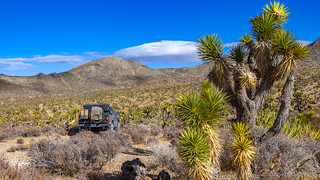
There was one bummer however: the lack of sleep over the last two days, coupled with the copious mileage we'd travelled had @mrs.turbodb completely exhausted. As such - as I set out from the rock house ruins by our parking spot - I found myself hiking solo, only the handheld ham radio to keep me company.


Unlike most hikes - which follow at least some semblance of a trail, no matter how lightly travelled it is in modern times - the hike through Alaska Hill is mostly cross-country. Armed only with a set of interesting points and a general description of the route, a big part of the fun of a trek like this - for me - is finding my own way, knowing that no one else has done it exactly the same way. Seeing things that others have seen, but different. And so, I started up the wash, excited for the unknown.
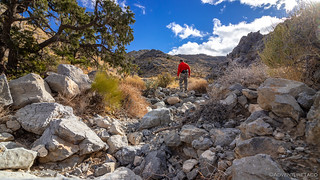
Quickly, the wash got steeper. Even with only four miles of total length, I ended up gaining more than 1500 feet of elevation, much of it in the first mile or so of the hike. The ease of hiking was not improved by the "terrain" either - piles of mine tailings like sand dunes - my feet slipping half a step down for every step up!

The tailings of the Monitor Mine weren't the only sign of the activity that'd taken place here. One of the most successful silver mines in the area, old rock walls and tools dotted the wash, making for interesting distractions to the strenuous clambering.
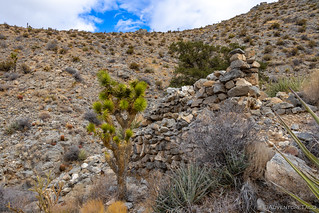
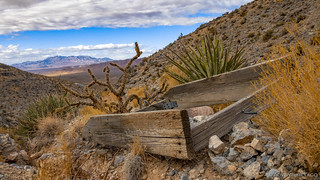
Eventually, I found myself some three-quarters of a mile from where I started, the Tacoma visible in the distance. In just over half an hour, I'd reached the terminus of our hike the year before - the cabin of the Beatrice Mine. 2020 had not been good to the cabin, which had all four walls and a roof, the last time we'd ventured this direction. Now, just one short year later, one of the walls had fallen down completely, and what was left of the roof wasn't far behind. What a year. 
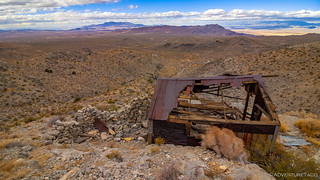
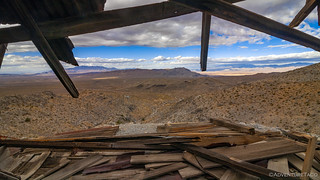
Now able to explore the area without 10" of snow covering everything up, I continued up the wash - or rather, back down into it - past no fewer than 15 old mine shafts and tailings piles from the Beatrice No. 1 and No. 2 mines, as well as the Monitor, which continued to work its way up toward the ridgeline. Poking along, my attention was pulled in multiple directions. Up-and-around - the stunning views only getting better as I climbed higher; but also down - colorful rocks liberated from the hillsides, still beckoning passers-by, as they lay - uncovered - on the ground.
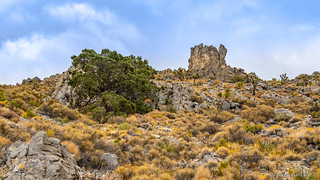
There's a path through there, just waiting to be discovered.

The view north, towards the Mesquite Mountains.

Blue anyone?

How about green?

Holy blue, green and purple, Batman!
A few hundred vertical feet further, and I reached the top of the wash I'd been climbing - the entirety of the hike now below me, though only a third of the overall distance complete. My next task was traversing the ridge to the adjacent wash, where more mines and ultimately a trail back to the truck, awaited.
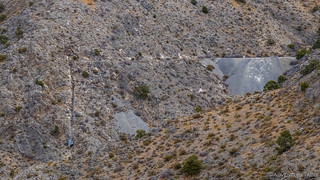
One wash over - the ore chute of the Alley Mine, cut into the steep hillside.
Navigating between rocks, chollo cactus, and creosote, the horizontal movement was a welcome change from the 45º incline I'd been hiking to this point, and I made good time - stopping only to admire the dried flower of a dwarf agave, a large collapsed mine shaft I found in the hillside, and a juniper tree full of berries.
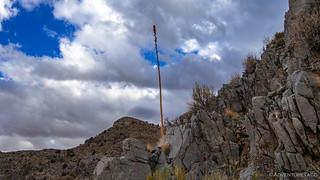
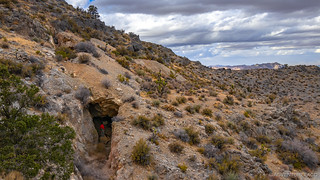

Soon, I was at the base of the Alley Mine's chute. I'd lost elevation on the traverse - an unfortunate happenstance, as I'd have to regain that elevation to check out the entirety of the mine - but with so much to explore, I was happy to see it any way I could.

Ore chute. Not as straight-down-the-hill as it looked from a distance. This sinuous contraption of boards and corrugated iron dropped ore 180 feet from the mine's high workings down the rocky mountain side.

Fuel barrels, everywhere.
From the bottom of the ore chute, I climbed again - to an old rock cabin at the top of an adjacent claim - the Lizzie Bullock No 2. As with the Beatrice, this cabin has seen better days - much of what was once the front room, now collapsed. Still, the middle wall and cold storage room built into the mountain were in great shape, adding intrigue to a place that would have offered a restful place to soak in the views of the canyon and Mesquite Valley.


By this point, I'd been hiking for a couple hours and it was nearing 3:00pm - only 90 minutes or so until the sun set on this, one of the shortest days of the year. I radioed back to @mrs.turbodb that I'd reached my last mine and was headed back - her voice loud and clear as she responded to let me know that she'd finally figured out how to work the Kenwood D710G ham radio in the truck.
And so, I headed down the mountain, looking back one final time at the workings as I hustled along.

Even with nearly two miles back to the Tacoma, I wasn't worried that I'd run out of light - the hiking down was much easier than up, and this wash had a road in it that we probably could have driven - had we known that was an option! Within 45 minutes I found myself cresting a short saddle between the two canyons, a hole in the hillside and metal grate over a shaft distracting me before my final descent to the trailhead.

Alaska Hill is covered in shafts. One of the most densely populated areas I've visited.
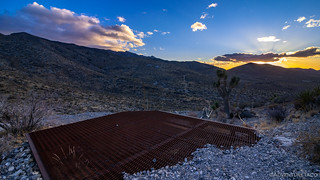
Of all the shafts in the area, this is the only one that's been covered - as far as I can tell.
As I reached the truck, @mrs.turbodb and I filled each other in on the highlights of our afternoons - each of us happy to have made the choices we'd made as far as the hike was concerned. And then - with the sun setting - we set about finding camp for the night. I'd wanted to make our way back toward the Colosseum Mine a bit - just so we were closer to our destination the following day - and so the fact that it was very breezy here in Alaska Hill made it an easy decision to look for something a little more sheltered.
We headed back towards Clark Mountain, the sun setting to our west - the bright yellows and oranges wowing us as we raced the waning light.


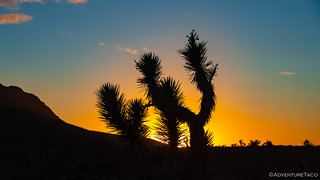
I'm sure we knew it at the time - our race to find camp before dark was a futile one. At some point we admitted that to ourselves, and I was soon back out of the truck, now capturing pinks and purples as the sun dropped further below the horizon.
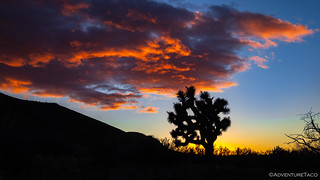

Still only about 5:15pm, we ended up exploring two or three possible places to camp before settling on one that optimized shelter-from-the-wind over views. It would mean no hope of sunrise in the morning, but after only three hours of sleep in the last two days, we both needed the rest - we'd have plenty of chances to wake up to something spectacular on the rest of the trip!
A quick dinner of tacorritos with guacamole and copious amounts of water and we called it a night - climbing into bed well before 7:30pm, and falling asleep only a few minutes later. The wind would stop by midnight, and I think we both slept reasonably well - even as the temps dropped into the high 20°Fs overnight - our down comforters and Exped MegaMat keeping us well insulated from the elements.
It'd been a great first day in the Preserve, and things had mostly gone to plan. Fortunately for us, that wouldn't be the case the following day... but that's another story.


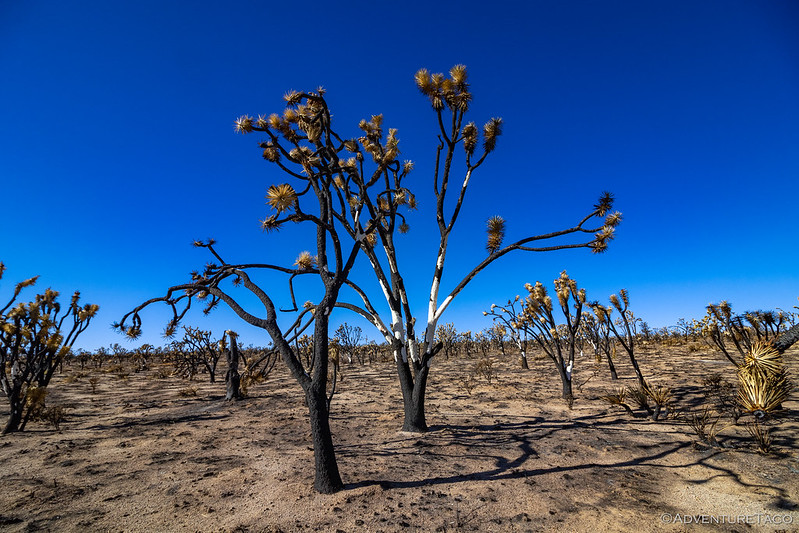



Great start to the trip and a really nice sunset. Just FYI, your captions for the colored rocks are mixed up 😉
Thanks! And thanks for the heads up on the captions - I've fixed them!